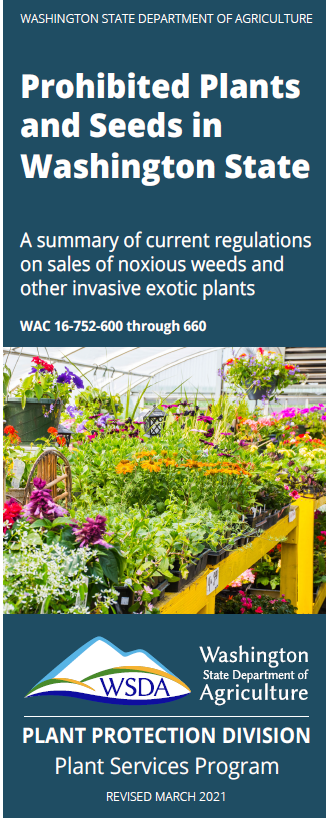In a big boost to preventing further introductions of invasive plants, 12 new species have been added to the state’s quarantine list. More than half of the added species were used as ornamental landscape plants and have since escaped into natural areas and farmland. The remainder have mostly been introduced by accident as seed “hitchhikers.” All but one of the added species are also on the Washington state noxious weed list, although requirements for control vary by plant species and county designations (Washington’s noxious weed laws and lists). For species such as South American spongeplant that are extremely uncommon in Washington, or haven’t even gotten here yet, preventing sale will help prevent them from spreading further. And even for species like poison-hemlock, spurge laurel, and yellow flag iris that are already widespread in Washington, stopping their sale and distribution goes a long way to preventing even more costly and damaging impacts. The cheapest and most effective type of weed control is always to prevent the problem in the first place!
The following species are now “regulated articles,” according to the rule posted by WSDA in February, and effective March 11, 2021:
American spongeplant (Limnobium spongia)
Annual bugloss (Lycopsis arvensis)
Hoary alyssum (Berteroa incana)
Italian arum (Arum italicum)
Myrtle spurge (Euphorbia myrsinites)
Poison hemlock (Conium maculatum)
Ravenna grass (Tripidium ravennae)
Small-flowered jewelweed (Impatiens parviflora)
South American spongeplant (Limnobium laevigatum)
Spurge laurel (Daphne laureola)
Tree-of-heaven (Ailanthus altissima)
Yellow flag iris (Iris pseudacorus)
The quarantine list, also called the prohibited plants list, is maintained by the Washington State Department of Agriculture (WSDA) to protect Washington agriculture and natural resources and to prevent public and private costs of control of harmful plant species. According to the state law, “it is prohibited to transport, buy, sell, offer for sale, or to distribute plants or plant parts of the regulated species listed in WAC 16-752-610 into or within the state of Washington or to sell, offer for sale, or distribute seed packets of the seed, flower seed blends, or wildflower mixes of these regulated species into or within the state of Washington.”
WSDA’s Nursery Licensing and Inspection Program oversees the implementation of the quarantine law. When there are prohibited species being sold, field inspectors visit the business to verify the species, inform them of the legal requirements, and make sure banned materials are discarded safely. To report the sale or distribution of any prohibited species, or to find out more information, contact WSDA Plant Services Program at Nursery@agr.wa.gov or call 360-902-1874.
To see photos of all the plants on the quarantine list, visit Washington State Noxious Weed Board’s website: https://www.nwcb.wa.gov/noxious-weed-quarantine-list
If you are looking for non-invasive alternatives to these or other banned species, consider introducing more native plants into your landscape. Visit WNPS or kingcounty.gov/gonative for information and ideas.
Another great resource is your local nursery or garden store! Ask them what alternatives they have that are not invasive in this area that share the positive qualities of the prohibited plant. There are so many wonderful plants out there that are much better behaved!
LEARN MORE
Noxious weed information in King County, Washington
Washington State Noxious Weed Laws and Lists












I am pleased to see these additions to the list, and wish we could add English Holly to the list!!!
That would be helpful indeed! Until then we just have to get the word out through education. 🙂
And what about English Iv (Hedera spp.)? I don’t see it on the list, so I presume it is still being sold, unlike in Oregon. How do we get that on the list?
Yes, that species (or really group of species) is a problem for sure and it would be helpful to add it to the Washington list. Unfortunately English ivy includes a large number of cultivars, subspecies, and even different species, so it’s a big challenge for the quarantine process in Washington to figure out how to list it. WSDA and the WA State Noxious Weed Board have been working on finding a way to do it, but like you say it hasn’t happened yet. In the meantime, we encourage everyone to talk to their friends and neighbors, and to consider other types of groundcovers. Also as a customer, we can talk to our local garden stores and nurseries and encourage them to start moving away from English ivy in Washington voluntarily. And of course we can all help by joining volunteer events to remove ivy from our parks and forests!
This is amazing….but so wanted more english ivy, holly and laurel on there :(…it’s taking years to get rid of it from our property and it’s just swallowing all the forest around us!
Yes I agree, but hopefully word is getting out to people about the problems with those plants too and they won’t get planted as much. Thanks for all the work you are doing to get them out of your property!